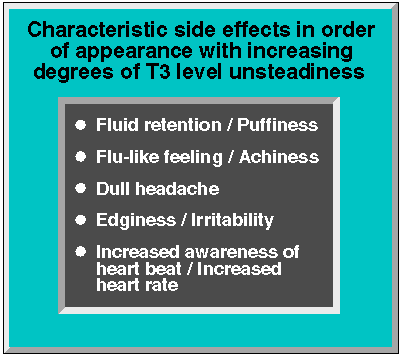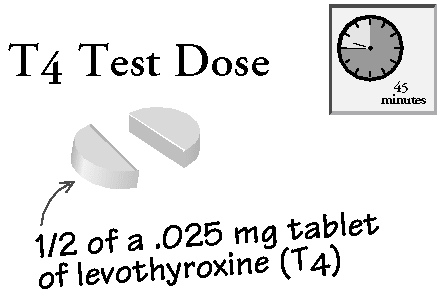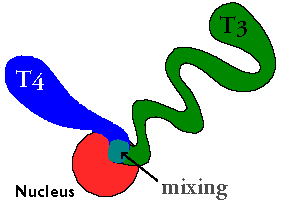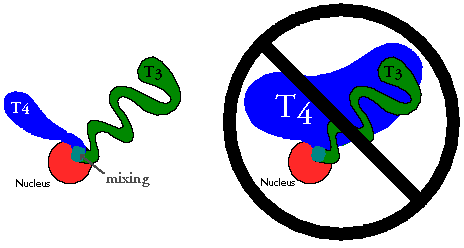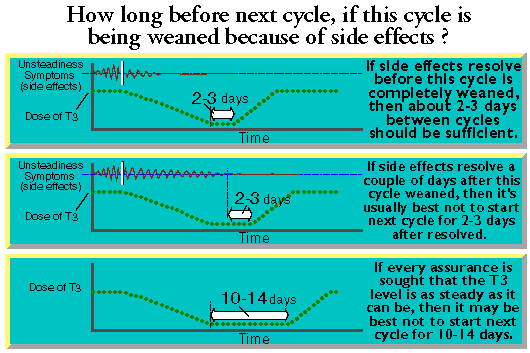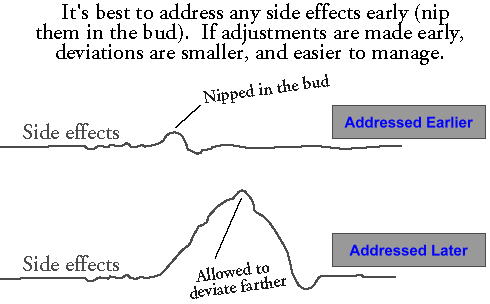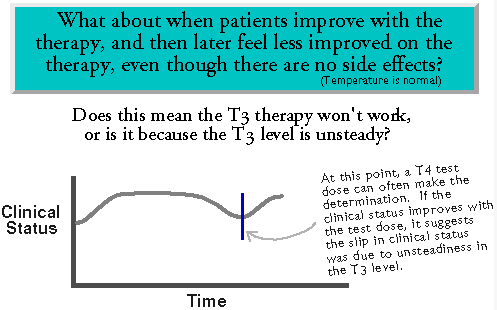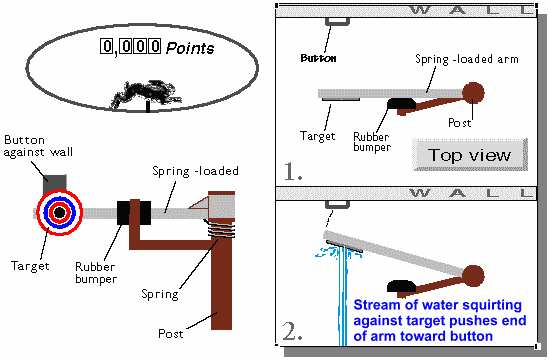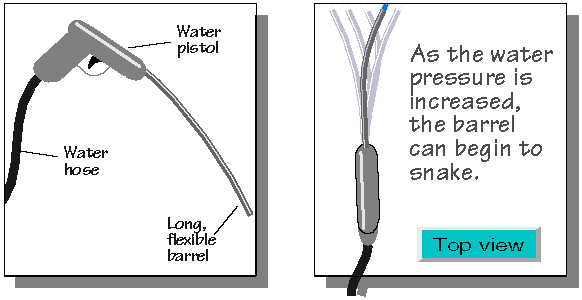As mentioned previously, a person may get characteristic side effects if the T3 levels become unsteady. A lot of what people think are symptoms of thyroid toxicity are really due to thyroid hormone level unsteadiness.
The most common side effect is fluid retention, not severe pedal edema, but a little bit of fluid retention and puffiness in the hands that can cause some achiness, and tightness of the rings. Patients can also complain of dull headache, edginess, irritability, and then increased awareness of the heartbeat and/or increased heart rate. Patients sometimes describe the side effects as feeling flu-like.
It is easy to confuse these symptoms with those of T3 toxicity due to too much T3, as opposed to unsteady T3.
Very much of what people consider to be symptoms or side effects of T3 or T4 toxicity in terms of excessive thyroid hormone levels is really due to unsteady thyroid hormone levels.
And the distinction can be made pretty well by determining if the person’s temperature is above or below normal, and by use of a T4 test dose.
Side effects of T3 unsteadiness often respond dramatically about 45 minutes after taking half of a .025 mg tablet of T4.
The litmus test for T3 unsteadiness is a T4 test dose, which involves giving the patient half of a .025 mg tablet of levothyroxine (T4, e.g. Synthroid).
.025 mg is the smallest strength typically made, and I recommend giving the patient just half of the tablet.
Patients who are complaining of symptoms of T3 unsteadiness such as achiness, shakiness, or irritability, can often have their symptoms dramatically resolve about 45 minutes after the T4 dose.
Most doctors would not expect a patient’s symptoms that appear to be due to excessive thyroid hormones, to disappear upon the addition of more thyroid hormone. But they often do.
Interestingly, it is usually not 30 minutes, and usually not an hour, but usually 45 minutes after the T4 test dose that the improvement will be noticed.
The T4 of the test dose is absorbed, travels to the cells of the body, and mixes with and averages against the unsteady T3 levels. This side effects typically respond dramatically without a drop in the temperature.
The half-life of T4 is 7.5 days, so certainly very little happens to the T4 itself within 45 minutes. 45 minutes is just enough time for the T4 to get absorbed from the gut, enter the bloodstream, and travel to the cells of the body.
T4 is a thyroid hormone receptor agonist but it is 4 times less potent, and three times longer acting than T3. So it’s like a wet blanket compared to T3.
I believe that by floating a little T4 into the system, one can coat the receptors, to provide some impedance against the unmitigated banging of the receptors by unsteady T3 levels.
In this way the T3 and T4 stimulation statistically average to provide for a steadier stimulation of the cells. Characteristically, the T4 test dose does not cause a drop in the temperature, benefits, or energy levels.
This test dose is so often effective that it can almost be considered to be an antidote for T3 unsteadiness (which is why I called it a litmus test for unsteadiness).
If a person’s side effects are coming from T3 therapy, then the patient is absorbing the T3 therapy. If so, then almost certainly, the patient will absorb the T4, and it will go into her bloodstream, and it will go to the cells of her body, and it will go to the receptor site, and it will compete and average against the T3.
Good response to the T4 test says can be considered confirmation of suspected T3 unsteadiness. But the T4 should not be taken other than PRN (Please Repeat as Necessary) because that can go against what we’re trying to accomplish with the T3 therapy.
When in 45 minutes or so, the patients’ symptoms resolve or significantly improve, one can consider it a confirmation the patient was experiencing T3 unsteadiness.
Note: In a typical case, there was no improvement (in her symptoms suspicious for T3 unsteadiness) after 45 minutes or so, and I told the patient I felt that it was extremely unlikely that her symptoms could be related to the T3 she was taking. The following day she called to say: “You were right Dr. Wilson, everyone in my family has come down with the flu and so have I, I don’t think it was the T3.” When her flu cleared, so did her complaints of achiness, fatigue, and edginess.
When a patient’s symptoms resolve with the T4 test dose, then she better knows the difference between “good” and “bad.” I point out that if she ever feels similarly badly again during the T3 therapy, she should take the T4 again; but that if she doesn’t, she shouldn’t take it because that can go against what we’re trying to accomplish with the T3 therapy.
Note: The resetting of the thyroid system seems to correlate with depletion of RT3 levels, which occurs with depletion of T4 levels, which will not occur if the patient is taking T4 regularly. Also, it seems that patients who are taking T4 regularly are more susceptible to their low thyroid symptoms worsening under stress than are patients who are taking T3 alone (presumably because of their T3 supply being somewhat dependent on enzymatic conversion of T4).
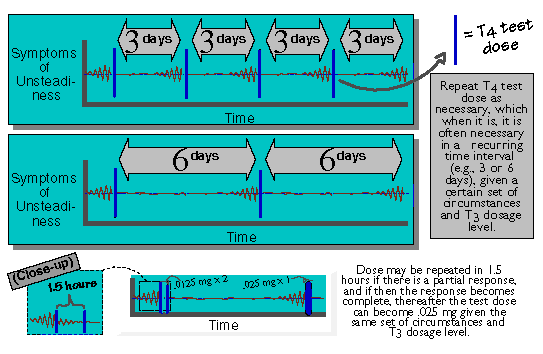
The T4 test dose is sometimes needed in a recurring time interval and sometimes only once. The test may be repeated in about an hour and a half if there is a partial response.
The T4 dose is taken PRN for circumstances suspicious of unsteadiness, and not on a continual basis. It is taken only as needed. As it turns out, the T4 test dose is often not needed more than once, if at all. But if it is needed again it is often needed in a recurring time interval. For example, a patient taking 60 mcg of T3 BID, may find she needs .0125 mg of T4 every 4 days. Incidently, if her dose of T3 goes up to 75 mcg BID she may find she needs the .0125 mg of T4 every 3 days.
It also varies from person to person, some patients may find that on their current dose, they need to repeat the T4 test dose every 7 days; others on that same dose, every 5 days; others, every 2 days; some, every day; and still others not at all.
If a patient has not been taking the T3 therapy very much on time, and the symptoms of unsteadiness are not very significant, it might be reasonable to just have the patient resume better compliance, and to let things settle down on their own without giving a T4 test dose. To review, it would usually take 4 – 5 days for things to settle down with this approach, but may take as long as 10 – 14 days.
In some cases the .0125 mg dose provides for a partial response, but not a full one. This most often occurs when patients are taking more than about 45 mcg p.o. BID of the T3.
In such cases I repeat the .0125 mg dose of T4 after about an hour or hour and a half to see if full resolution can be obtained with a more proportionate dose, but don’t usually repeat it again if it isn’t. When it is obtained with the repeat dose, and the patient ever needs a dose of T4 again while on the same dose of T3, I recommend the patient to use T4 test doses of .025 mg thereafter, instead of .0125 mg.
Sometimes it’s best to wean off one cycle of T3 to let things steady down again and then to start another. If any side effects persist after the cycle has been weaned it’s usually best not to start the next cycle until 2-3 days after the side effects have resolved completely.
When the side effects are severe, or continue in spite of T4 test dosing (because T4 test dosing is sometimes not enough to “recapture” the steadiness of very unsteady T3 levels), it is usually best to wean down off the T3 therapy to let things steady down again. In such cases, things usually steady down before the cycle has been completely weaned, so 2-3 days between cycles should be sufficient.
Or, the side effects may not resolve until after the patient has been weaned completely off the cycle for a couple of days. When this occurs, it’s usually best to have the patient stay off another couple of days after the side effects have resolved before starting another cycle (if another is started), to allow things to settle down sufficiently to get a nice steady start on the next cycle.
If every assurance is being sought that the patient’s T3 level is as steady as it can possibly be, then it may be advisable to stay off the T3 cycle for 10 – 14 days before starting the next cycle. But in most circumstances it’s not necessary to wait that long. It’s important for the level to be as steady as possible, but it’s not good for the treatment to take unnecessarily long, so usually 2 or 3 days between cycles is sufficient.
Note: One example of when one might seek every assurance the T3 is as steady as possible follows: A patient starts a cycle of T3, but does not respond as well as one might expect based on presentation. Upon questioning the patient, it seems that T3 unsteadiness due to not taking the medicine very well on time might explain it. The patient responds somewhat to a T4 test dose, but it is felt that it would be better to wean and restart. She weans and restarts and still doesn’t do very well, but she only stayed off 2 days between cycles which may not have been enough time to settle down. The patient is disillusioned. It’s felt that unsteadiness might explain why she hasn’t done better on the treatment, so the patient stays off the T3 for 10-14 days this time between cycles, to rule out that possibility as well as possible.
It’s best to keep things on track from the start. Patients should have no complaints. But if they do the complaints should be addressed early.
T3 therapy should not be considered a “no pain, no gain” situation. With therapy, patients should only feel better, with no complaints. Any complaints should be considered indicators that the thyroid hormone treatment might be less than ideally adjusted.
It is easier to manage any potential side effects, by “nipping them in the bud” as soon as they appear, rather than letting them develop into harder to manage problems. Keeping a person on track, saves many steps.
It is best to keep things on track as much as possible from the start.
A patient may experience decreased symptomatic improvement (drop in clinical status) due to T3 unsteadiness before she ever develops any side effects. If you suspect T3 unsteadiness my be robbing your patient of some benefits, a T4 test dose can be very illuminating.
The T4 test dose is useful not only with respect to side effects but also with respect to progress in symptomatic improvement.
Unsteady T3 levels sometimes result in decreased symptomatic improvement even without the presence of side effects.
If a patient’s body temperature is averaging 98.6, but her symptoms are not as improved as one might expect they should be, it may be because of unsteady T3 levels (from inconsistent dosing times, strange sleep or work hours, etc.).
This theory is easy to check, because if the patient’s symptoms improve significantly within 45 minutes of a T4 test dose, then it is likely there was some T3 unsteadiness that can be addressed accordingly.
The T4 test dose is extremely useful in many situations, and can give one a great deal of information, and give one a lot of guidance in situations where T3 unsteadiness is suspected.

We have discussed many principles of T3 management, including cycling on T3 to reset the system, the significance of and occasional difficulty in holding T3 levels steady in the meantime, the T4 test dose, and weaning T3 therapy when indicated.
The following analogy encompasses principles that have already been presented in previous analogies. Previous analogies were to emphasize certain points. This analogy summarizes and combines these points in such a way as to emphasize the “feel” of the system.
Suppose there was a carnival game that involved directing a stream of water from a hand-held water pistol at a circular target mounted on a spring-loaded arm which is mounted to a vertical post. In the starting position, the tension of the spring holds the arm against a rubber bumper mounted to the post. By pushing the target to swing the arm against the resistance of the spring, you can cause the arm to swing backward and push a button on the wall behind it. If the button is held down long enough, a plastic rabbit is caused to move around a circular track collecting points. There’s a catch though, the more constant the pressure on the button, the faster the rabbit moves; and the button has to be held down continuously for one second, before it will move at all. There’s one more thing, the water gun you’re using has a flexible barrel that’s 1.5 feet long. You can control the flow of water by operating a knob with your other hand.
You begin by increasing the water pressure such that the pencil-thin stream begins pushing against the target and moving the arm. Holding your aim as steady as you can, you increase the water pressure, pushing the target backward and causing it to “hover” there.
As you increase the water pressure more and more, the barrel of your gun begins to snake ever so slightly. If it begins to snake a little more, some of the water stream may miss the target, allowing the arm to begin swinging forward. In such a case, if the full stream can then hit the target, and continue hitting it, the target would then be pushed backward to resume its previous position. But if the full stream hits the target for only a short time before it missed it again, the arm would swing quickly backward (especially if it caught the target just as it was already headed backward after bouncing off the bumper) and then forward again. If the stream is so unsteady as to keep hitting and missing the target, then it could cause the spring-loaded arm to start bouncing and clanging back and forth (against the bumper at one end and against the button, or spring’s tension at the other).
At such a time, rules permit you to carefully hold the snaking barrel for a second or two with your other hand to see if you can settle it down again. If you are unsuccessful, the best thing for you to do is to gradually turn off the water to let the arm settle down to it’s resting position, and to allow the barrel to stop its snaking motion. Then you can get a fresh start, directing the steady stream of water against the target, while gradually increasing the water pressure, doing what you can to hold the barrel as steady as possible to minimize snaking and to maximize control and progress.
If you do turn off the water, and turn it on again, there’s good news and bad news. The good news is that if at some point you have succeeded in causing the rabbit to move, one of the rewards is that if you then turn the water all the way off to start over, the post upon which the swinging arm is mounted, moves closer to the wall (so less pressure on the target is required on the next try to press and hold down the button).
The bad news is that the rabbit won’t be moving in the meantime. Incidently, the more slowly the arm is allowed to swing forward to rest against the bumper, the farther the post is likely to move toward the wall.
The stream of water is used to reflect how T3 is being produced, having its effect, and being dissipated continuously.
The spring-loading of the arm represents how the body (through negative feedback inhibition) responds to therapy. It helps show that there are two important forces at work: The T3 therapy, and the body’s response to that therapy. Both must be taken into account to keep things steady.
The circling of the rabbit is likened to resolution of the patient’s symptoms of Wilson’s Temperature Syndrome.
Having to hold the button down continuously for a second after each interruption before progress is made or resumed reflects the need for the temperature to be not only high enough, but also steady enough for things to work well. And the rabbit moving faster with the more constant the pressure on the button, reflects that the steadier the better.
In the above analogy, a water gun with a flexible barrel was used to represent exogenous T3 therapy, reflecting that exogenous T3 therapy is a somewhat unsteady source of T3 (as compared to endogenous production).
The snaking of the barrel with increasing water pressure reflects that the higher the dose of T3 therapy the harder it is to keep it steady.
The bouncing around of the arm, and the need to hold the button down long enough to get the benefit represents that sometimes less stimulation that is better directed can result in more progress than more stimulation
that is poorly directed. Steadiness is everything. The active form of thyroid hormone is being used, not a prohormone that must be converted, and that changes everything. This should change the way one thinks about thyroid treatment.
The system is dynamic and is in fluid motion. And the motion of T3 stimulation has some bearing on its effectiveness. It’s not just a matter of quantity, it’s also a matter of how that quantity is being directed. So when the T3 dose is increased a “notch” it is not so static as that sounds.
The use of one hand momentarily to try to steady the stream, is like the T4 test dose one can use to try to steady unsteady T3 levels/stimulation.
Turning the water off and then on again gradually, represents cycling off and on the T3 therapy.
The bouncing of the arm against the rubber bumper for a while as it settles down represents that once the system is unsteady, it can take a while to settle back down again, especially if left on its own.
Also, if one is going to turn the water off and start over, it would be wise to turn it off gradually, using the stream of water to help the arm move forward more gently to rest against the bumper, rather than to discontinue the water (T3) abruptly or heedlessly. By doing so the bouncing, if any, would stop sooner.
Letting the arm settle down to get a fresh start illustrates the benefit of not starting over by aiming at a target that’s already bouncing out of control. If one starts a try (cycle) with things out of control (arm bouncing against bumper instead of resting against it), there’s a good chance the try will stay out of control, without the steadiness being recaptured. Not only will this probably result in no progress of the
rabbit, but also it will only further delay the fresh start one will need to have a much better shot at making such progress. Thus, it’s important with each cycle to get a good steady start, and to keep the T3 therapy as steady as possible right from that start.
The post moving closer to the wall after a try that moves the rabbit, represents how patients frequently need less T3 on subsequent cycles than they did on previous ones.
The post being likely to move farther if the arm is allowed to swing forward more slowly represents how the body is more likely to retain and maintain naturally what the cycle re-established artificially, if the body is given enough time to come up endogenously to take back good control of the system and run with it. Weaning a cycle too fast can squander some or all of the benefit of that cycle. On the other hand, one doesn’t want to wean cycles unnecessarily slowly since one doesn’t want the treatment to last unnecessarily long (p98).
The rabbit not moving while the water is being turned all the way off (unless the post moves so far forward that the button is pressed without any water pressure – likened to the system being reset well enough to remain functioning well even after the treatment has been discontinued) brings up a frequent choice: When a try is going well, and the rabbit is moving well, do you stay with what you’re doing, to enjoy the benefits and not rock the boat? – Or – Do you turn the water off to see if you can use less (so it’ll be easier to hold steady) or no water pressure the next try (if the system is fully reset with post pressing button on its own)? See question Q9 for a discussion that will help you decide when to choose one option, and when to choose the other.

